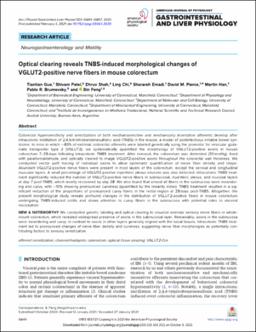Optical clearing reveals TNBS-induced morphological changes of VGLUT2-positive nerve fibers in mouse colorectum

View/
Date
2021-04Author
Brumovsky, Pablo.
Guo, Tiantian.
Patel, Shivam.
Et al.
Metadata
Show full item recordAbstract
Abstract
Colorectal hypersensitivity and sensitization of both mechanosensitive and mechanically insensitive afferents develop after intracolonic instillation of 2,4,6-trinitrobenzenesulfonic acid (TNBS) in the mouse, a model of postinfectious irritable bowel syndrome. In mice in which ∼80% of extrinsic colorectal afferents were labeled genetically using the promotor for vesicular glutamate transporter type 2 (VGLUT2), we systematically quantified the morphology of VGLUT2-positive axons in mouse colorectum 7-28 days following intracolonic TNBS treatment. After removal, the colorectum was distended (20 mmHg), fixed with paraformaldehyde, and optically cleared to image VGLUT2-positive axons throughout the colorectal wall thickness. We conducted vector path tracing of individual axons to allow systematic quantification of nerve fiber density and shape. Abundant VGLUT2-positive nerve fibers were present in most layers of the colorectum, except the serosal and longitudinal muscular layers. A small percentage of VGLUT2-positive myenteric plexus neurons was also detected. Intracolonic TNBS treatment significantly reduced the number of VGLUT2-positive nerve fibers in submucosal, myenteric plexus, and mucosal layers at day 7 post-TNBS, which mostly recovered by day 28. We also found that almost all fibers in the submucosa were meandering and curvy, with ∼10% showing pronounced curviness (quantified by the linearity index). TNBS treatment resulted in a significant reduction of the proportions of pronounced curvy fibers in the rectal region at 28 days post-TNBS. Altogether, the present morphological study reveals profound changes in the distribution of VGLUT2-positive fibers in mouse colorectum undergoing TNBS-induced colitis and draws attention to curvy fibers in the submucosa with potential roles in visceral nociception.NEW & NOTEWORTHY We conducted genetic labeling and optical clearing to visualize extrinsic sensory nerve fibers in whole-mount colorectum, which revealed widespread presence of axons in the submucosal layer. Remarkably, axons in the submucosa were meandering and curvy, in contrast to axons in other layers generally aligned with the basal tissues. Intracolonic TNBS treatment led to pronounced changes of nerve fiber density and curviness, suggesting nerve fiber morphologies as potentially contributing factors to sensory sensitization.
Keywords: VGLUT2-Cre; afferent sensitization; channelrhodopsin; colorectum; optical tissue clearing.
Collections
The following license files are associated with this item:

